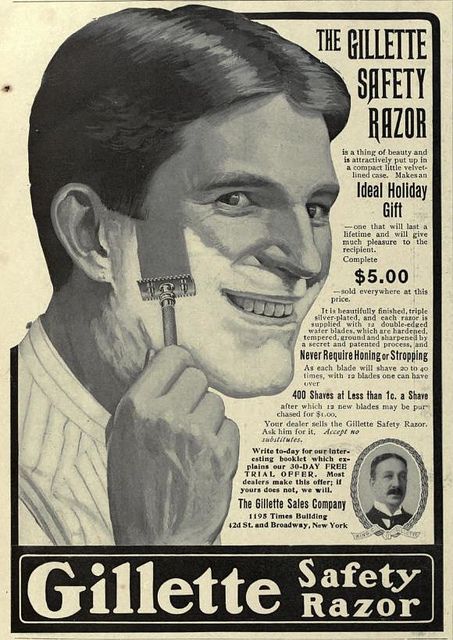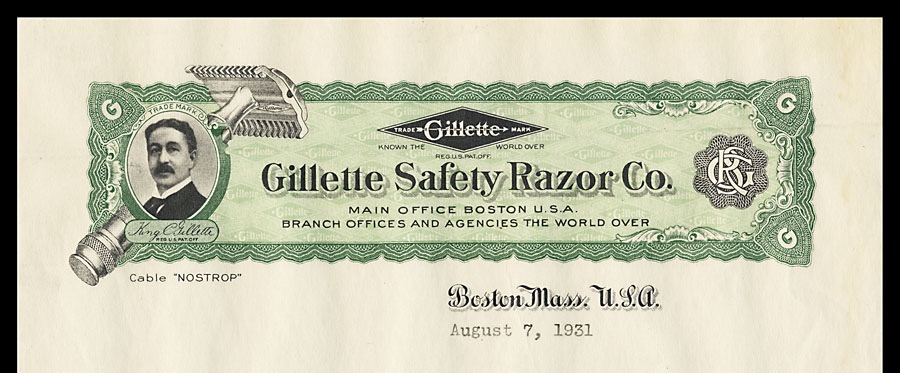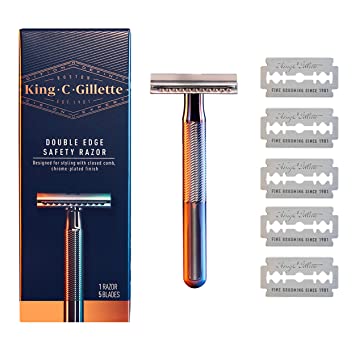King Camp Gillette: The inventor of the razor
Shaving was a difficult task until the early 20th century. The razor had to be sharpened before shaving, resulting in a longer shaving time.

Although many studies were conducted to develop an alternative tool to the razor for shaving, successful results could not be obtained from them. The inventor of the razor, King Camp Gillette, has made a radical change in the shaving habits that have been going on for hundreds of years. While working on steel strips and brass pieces, he invented the razor and made shaving easier thanks to the shaver he developed. The razors, which it started to sell in 1903 together with the disposable razor, were the harbinger of a new shaving style beyond being a new product. In a short time, razors and shavers became a part of the daily life of those who take care of their personal care. Even after all this time, the razor is still known by the name of King Camp Gillette.

Who is King Camp Gillette? (1855-1932)
King Camp Gillette was born on January 5, 1855, in Fond du Lac, Wisconsin, USA, as the third child of a family of three children. His father was a postmaster and an editor for a newspaper. His mother was a disciplined housewife. In the family environment, little King learned to use time effectively from an early age. For the middle-income Gillette family, life was full of opportunities. To make good use of these opportunities, time planning was important. His mother and father, who raised Little King with this in mind, decided to settle in Illinois for their children to receive a good education. Compared to Fond du Lac, Illinois had better opportunities. His father wanted King to go into business in the future and become a successful businessman. He also engaged in trade for a while, but was unsuccessful. There were wider opportunities for trade in Illinois. However, the great Chicago fire that took place in October 1871 caused the Gillette family to lose all their property.
After the Chicago fire, the Gillette family moved to New York. During his childhood years in Illinois, King Camp Gillette was a clerk in a hardware store during his time off from school. When his father apprenticed him to the hardware store, he wanted him to learn the intricacies of the trade. The Gillette family, who settled in New York, was trying to establish a new life, but their financial means were limited. For this reason, King Camp Gillette decided to continue his education instead of continuing his education in the field of commerce. He was engaged in sales jobs in different sectors and traveled a lot. Within a few years, King Camp Gillette has gained significant experience in the field of mobile sales. In his spare time, he examined the products he sold and made drawings on how the products could be improved. According to King Camp Gillette, the way to achieve success in the sale of a product was to know that product very well and to know very well what it does. Knowing the products motivated him to try to do better. Thus, King Camp Gillette began to move from peddling to inventor.
From Peddler to Inventor
King Camp Gillette's passion for invention actually started to show its first signs during his childhood years in Illinois. At home, her mother was developing some simple practical solutions to facilitate household chores, and finding new solutions to use kitchen utensils efficiently. While he was an apprentice in the hardware store, he had to get to know many tools and equipment due to his job. During his years in New York, King Camp Gillette started to use the knowledge and experience he had gained until that day in a commercial sense. While the self-confidence brought about by knowing the products increased the sales success, the success obtained from the sales created a natural motivation to develop new products. He also had a mechanic side. This aspect, which enables him to easily solve the problems in the products, made it easier for him to detect the defective points in the products. One of Gillette's most important interests was reading books. He was finding books that would enable him to improve himself, and thinking about new inventions in his spare time. In this process, the invention of the telephone and the invention of the light bulb increased King Camp Gillette's curiosity about inventions.
In 1890, King Camp Gillette married Atlanta Ella Gaines, the daughter of an Ohio oil merchant. During this period, he was working for the Baltimore Seal Company as a New England and New York representative. Serving in the bottling industry, this company met many needs of the industry with the new product types it developed. The crown bottle cap that can be folded over the bottle was just one of the new product types the company developed. This type of product was developed and patented by the company's president, William Painter. A close relationship soon emerged between Painter and King Camp Gillette. Thinking that King Camp Gillette could show its success in sales in the P&D and R&D processes, William Painter gave Gillette some tasks and enabled him to take part in the processes. King Camp Gillette, showing a successful performance in all the works given, quickly showed that it was successful in the field of P&D and R&D as well as in the sales field. By 1891, William Painter wanted King Camp Gillette to work on disposable products.
Invention of the Razor
In 1895, King Camp Gillette developed an idea that would change his life. Men have been shaving since the earliest times of history, but an effective solution to make shaving easier has still not been found. The methods used by the cavemen of thousands of years ago were essentially unchanged. The cutting tools used to trim beards had changed over time, but the method had hardly changed. Gold and copper razors were used in ancient Egypt and Rome. In the 18th century, the first steel-edged razor was used in England. Although numerous studies have been carried out to facilitate shaving, the desired improvement has not yet been achieved in the straight-edged razor blades that have been used for a long time. With the encouragement of William Painter, King Camp Gillette, who made important progress in his studies on disposable products, examined many materials to be used in new product types. One day, while shaving in front of the mirror, he thought how much easier shaving would be if he had a disposable razor. Razor sharpening and other operations while shaving could thus become a thing of the past.
For this purpose, King Camp Gillette started working on steel strip and brass parts. Thanks to the file and vice he used, he could easily process steel strips. The razor he would develop could have both facilitated the shaving process and saved the trouble of sharpening a razor, thanks to a special cutter to be used in it. The grip characteristics of the razor blade he designed in his mind should have been easy to adapt to hand movements. By 1899, King Camp Gillette succeeded in producing the first prototype of the razor blade. He made the cutting part of the razor from thin steel and cut the beards beautifully. He made a very important invention in the field of personal care by taking the patent of the product. However, he did not have the necessary capital to mass-produce and sell these products. It was very difficult to refine and sharpen the steel sufficiently. The product also had to be robust. Meeting William Emery Nickerson during this period enabled him to find the necessary resources.
Gillette Safety Razor Company
In 1901, King Camp Gillette founded Gillette Safety Razor Company in partnership with William Emery Nickerson and started mass production of razor blades. The invention of the razor both led to the emergence of a simple and effective product to be used in shaving, and also revealed the idea of a machine that facilitates beard trimming. Until then, the most frequently used tool in beard cutting was the razor. Although many efforts have been made to develop an alternative tool to the razor for shaving, none of them have yielded successful results. The invention of the razor was an important milestone in the development of the razor. Because the razor could cause injury when handled, which required making the razor safe to use. The word “safety” in the name of the company was especially chosen in this context. In the advertisements for the products, it was underlined that the shavers sold with the razor offered effective solutions in terms of safety. However, razors received more attention than razors. In the first sales that started in 1903, 168 razors and 61 machines were sold.
The inventor of the razor, King Camp Gillette, was no ordinary inventor. He was mainly trained in the sales field and gained experience in this field. His partner, William Emery Nickerson, was a graduate of the Massachusetts Institute of Technology and was open to innovation. However, developing a new product was not enough to be commercially successful. This new type of product developed promised to radically change and facilitate a habit that had been going on for hundreds of years. The fact that the promise was so great not only increased the interest in the product, but also increased the potential sales success of the product. In order to use these potentials effectively, King Camp Gillette made effective use of advertising channels. Moreover, thanks to the invention of the razor, a new page was opened in the field of personal care, and what should be written on this page should not consist of only razors. There were many more product types that could be developed in this area, from shaving soap to aftershave, from shaving kits to other shaving equipment. In line with these considerations, King Camp Gillette personally managed many P&D and R&D processes to grow his company.
The invention of the razor in the early 1900s ignited rapid growth in the personal care industry. The most important share in this growth naturally belonged to Gillette Safety Razor Company. While the number of shavers sold in just 2 years exceeded 90 thousand, the number of razors exceeded 12 million. Disposable razor blades appealed to users from almost all professions and made shaving easier. The price of the razor was suitable for the purchasing power of the people, and this allowed the products to reach large masses. What's more, King Camp Gillette has become one of the world's most recognizable inventors, thanks to his photograph featured on the products. Everyone who bought a razor and a razor to shave saw and knew the owner of this invention. Average shaving time was reduced from 20 minutes to just 5 minutes. It was also carefully underlined that the shaving experience offered by the razor blade does not harm the skin. Personal care products developed within the Gillette Safety Razor Company over time helped increase the success achieved with the invention of the razor.
In the first half of the 20th century, it was common for many military units to provide soldiers with uniforms and weapons, as well as Gillette shaving equipment. During World War I, King Camp Gillette supplied US soldiers with 3.5 million razors and 36 million razors. He retired from active duties in the company in 1913. He remained the honorary chairman of the company until his death in 1932. In this process, he did not neglect to take part in the P&D and R&D processes of the company. The first versions of razor blades, introduced in 1903, were developed over time. Numerous experiments have been made to make the blade angle more effective. The grip of the products has been simplified, and the opening and closing settings have also been improved. Over time, the first adjustable shavers with three settings for light, medium and thick beards were introduced. While the product variety of the company increased in the field of personal care, the growth of the personal care sector continued. Today, Gillette Safety Razor Company is one of the world's giants in the industry.

